TR-5006: High Throughput Oracle VLDB Implementation on Google Cloud NetApp Volumes with Data Guard
 Suggest changes
Suggest changes


Allen Cao, Niyaz Mohamed, NetApp
The solution provides an overview and details for configuring high throughput Oracle Very Large Database (VLDB) on Google Cloud NetApp Volumes (GCNV) with Oracle Data Guard in Google cloud.
Purpose
High throughput and mission-critical Oracle VLDB put a heavy demand on backend database storage. To meet service level agreement (SLA), the database storage must deliver the required capacity and high input/output operations per second (IOPS) while maintaining sub milliseconds latency performance. This is particularly challenging when deploying such a database workload in the public cloud with a shared storage resources environment. Not all storage platforms are created equal. GCNV is a premium storage service offered by Google that can support mission-critical Oracle Database deployments in Google cloud requiring sustained IOPS and low-latency performance characteristics. The architecture accommodates OLTP and OLAP workloads, with configurable service tiers supporting various performance profiles. GCNV delivers blazing-fast performance with sub milliseconds latency, achieving up to 4.5 GiBps per volume throughput with mixed read/write workloads.
Leveraging the fast snapshot backup (seconds) and clone (minutes) feature of GCNV, full-size copies of the production database can be cloned from Physical Standby on the fly to serve many other use cases such as DEV, UAT, etc. You can do away with an Active Data Guard license and inefficient and complex Snapshot Standby. The cost savings can be substantial. For a nominal Oracle Data Guard setup with 64 cores CPUs on both primary and standby Oracle servers, just the Active Data Guard licensing cost saving amounts to $1,472,000 based on the latest Oracle price list.
In this documentation, we demonstrate how to set up an Oracle VLDB with Data Guard configuration on GCNVS storage with multiple NFS volumes and Oracle ASM for storage load balancing. The standby database volumes can be quickly backed up via snapshot and cloned for read/write access. NetApp Solutions Engineering team provides an automation toolkit to create and refresh clones with streamlined lifecycle management.
This solution addresses the following use cases:
-
Implementation of Oracle VLDB in a Data Guard setting on GCNV storage service across Google cloud regions.
-
Snapshot backup and clone the physical standby database to serve use cases such as reporting, dev, test, etc. via automation.
Audience
This solution is intended for the following people:
-
A DBA who sets up Oracle VLDB with Data Guard in Google cloud for high availability, data protection, and disaster recovery.
-
A database solution architect interested in Oracle VLDB with Data Guard configuration in the Google cloud.
-
A storage administrator who manages GCNV storage that supports Oracle database.
-
An application owner who likes to stand up Oracle VLDB with Data Guard in a Google cloud environment.
Solution test and validation environment
The testing and validation of this solution was performed in a Google cloud lab setting that might not match the actual user deployment environment. For more information, see the section Key factors for deployment consideration.
Architecture
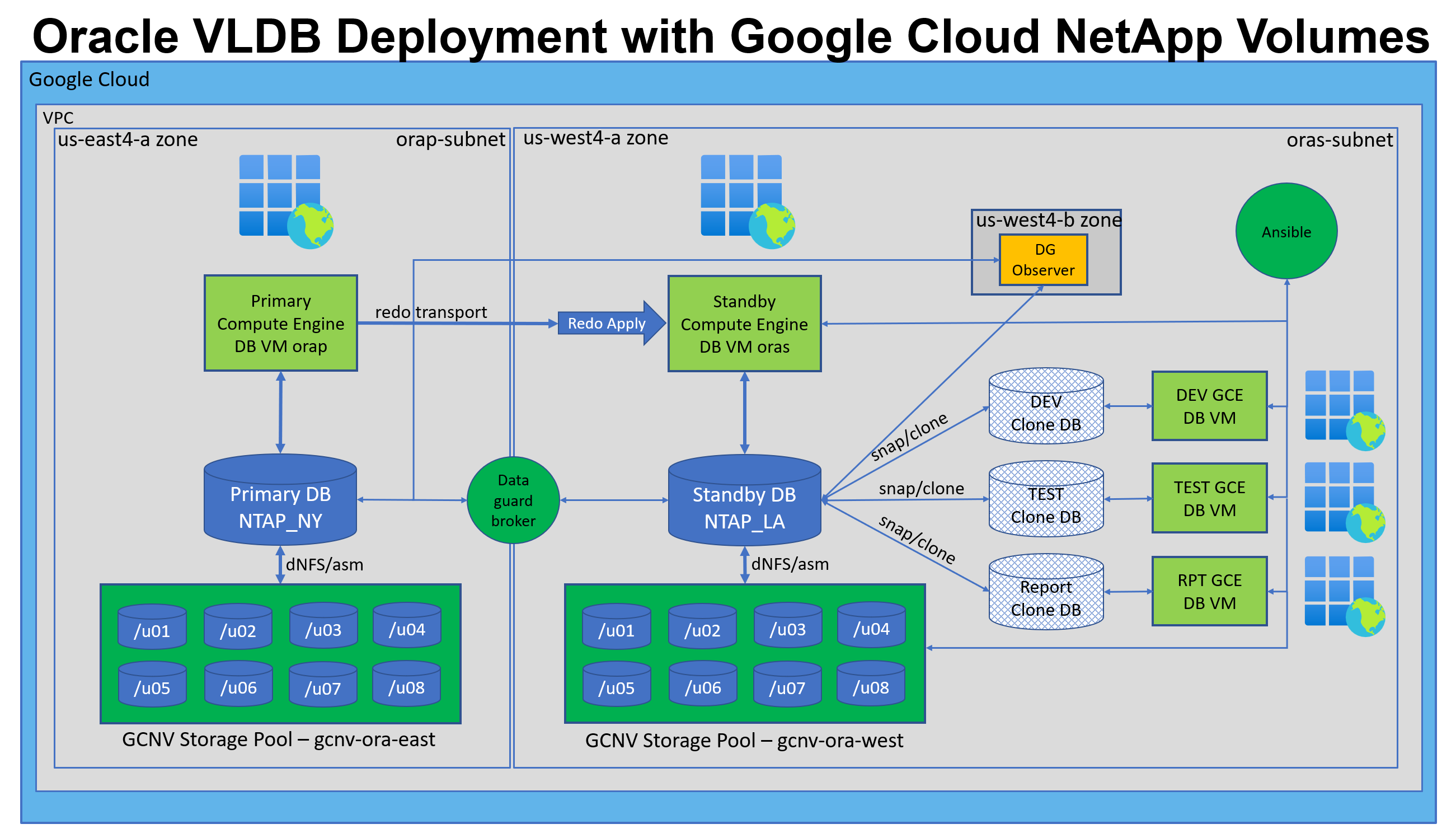
Hardware and software components
Hardware |
||
Google Cloud NetApp Volumes |
Current service offered by Google |
Two Storage Pools, Premium Service Level, Auto QoS |
Google Compute Engine VMs for DB Servers |
N1 (4 vcpus, 15 GiB memory) |
Four DB VMs, primary DB server, standby DB server, clone DB server, and Data Guard observer. |
Software |
||
RedHat Linux |
Red Hat Enterprise Linux 8.10 (Ootpa) - x86/64 |
RHEL Marketplace image, PAYG |
Oracle Grid Infrastructure |
Version 19.18 |
Applied RU patch p34762026_190000_Linux-x86-64.zip |
Oracle Database |
Version 19.18 |
Applied RU patch p34765931_190000_Linux-x86-64.zip |
dNFS OneOff Patch |
p32931941_190000_Linux-x86-64.zip |
Applied to both grid and database |
Oracle OPatch |
Version 12.2.0.1.36 |
Latest patch p6880880_190000_Linux-x86-64.zip |
Ansible |
Version core 2.16.2 |
python version - 3.10.13 |
NFS |
Version 3.0 |
dNFS enabled for Oracle |
Oracle VLDB Data Guard configuration with a simulated NY to LA DR setup
Database |
DB_UNIQUE_NAME |
Oracle Net Service Name |
Primary |
NTAP_NY |
NTAP_NY.cvs-pm-host-1p.internal |
Standby |
NTAP_LA |
NTAP_LA.cvs-pm-host-1p.internal |
Key factors for deployment consideration
-
Google Cloud NetApp Volumes Configuration. GCNV are allocated in the Google cloud as
Storage Pools. In these tests and validations, we deployed an 2 TiB storage pool to host Oracle primary database at the East4 region and a 4 TiB storage pool to host standby database and DB clone at the West4 region. GCNV storage pool has four service levels: Flex, Standard, Premium, and Extreme. The IO capacity of ANF capacity pool is based on the size of the capacity pool and its service level. At a capacity pool creation, you set storage pool location, service level, availability zone, and capacity of storage pool. For Oracle Data Guard configuration, Zonal availability should be sufficient as the Data Guard provides the database failover protection due to a zone level failure. -
Sizing the Database Volumes. For production deployment, NetApp recommends taking a full assessment of your Oracle database throughput requirement from Oracle AWR report. Take into consideration the database size, the throughput requirements, and service level when designing GCNV volumes layout for VLDB database. It is recommended to use only
PremiumorExtremeservice for Oracle database. The bandwidth is guaranteed at 64 MiB/s per TiB volume capacity up to maximum of 4.5 GiBps forPremiumservice and 128 MiB/s per TiB volume capacity up to 4.5 GiBps forExtremeservice. Higher throughput will need larger volume sizing to meet the requirement. -
Multiple Volumes and Load Balancing. A single large volume can provide similar performance level as multiple volumes with same aggregate volume size as the QoS is strictly enforced based on the volume sizing and storage pool service level. It is recommended to implement multiple volumes (multiple NFS mount points) for Oracle VLDB to better utilize shared backend GCNV storage resource pool and to meet throughput requirement exceeding 4.5 GiBps. Implement Oracle ASM for IO load balancing on multiple NFS volumes.
-
Google Compute Engine VM Instance Consideration. In these tests and validations, we used Compute Engine VM - N1 with 4 vCPUs and 15 GiB memory. You need to choose the Compute Engine DB VM instance appropriately for Oracle VLDB with high throughput requirement. Besides the number of vCPUs and the amount of RAM, the VM network bandwidth (ingress and egress or NIC throughput limit) can become a bottleneck before database storage throughput is reached.
-
dNFS Configuration. By using dNFS, an Oracle database running on a Google Compute Engine VM with GCNV storage can drive significantly more I/O than the native NFS client. Ensure that Oracle dNFS patch p32931941 is applied to address potential bugs.
Solution deployment
The following section demonstrates the configuration for Oracle VLDB on GCNV in an Oracle Data Guard setting between a primary Oracle DB in Google cloud of East region with GCNV storage to a physical standby Oracle DB in Google cloud of West region with GCNV storage.
Prerequisites for deployment
Details
Deployment requires the following prerequisites.
-
A Google cloud account has been set up and a project has been created within your Google account to deploy resources for setting up Oracle Data Guard.
-
Create a VPC and subnets that span the regions that are desired for Data Guard. For a resilient DR setup, consider to place the primary and standby DBs in different geographic locations that can tolerate major diaster in a local region.
-
From the Google cloud portal console, deploy four Google compute engine Linux VM instances, one as the primary Oracle DB server, one as the standby Oracle DB server, a clone target DB server, and an Oracle Data Guard observer. See the architecture diagram in the previous section for more details about the environment setup. Follow Google documentation Create a Linux VM instance in Compute Engine for detailed instructions.
Ensure that you have allocated at least 50G in the Azure VMs root volume in order to have sufficient space to stage Oracle installation files. Google compute engine VMs are locked down at instance level by default. To enable communication between VMs, a specific firewall rules should be created to open the TCP port traffic flow such as typical Oracle port 1521. -
From the Google cloud portal console, deploy two GCNV storage pools to host Oracle database volumes. Referred to documentation Create a storage pool quickstart for step-by-step instructions. Following are some screen shots for quick reference.

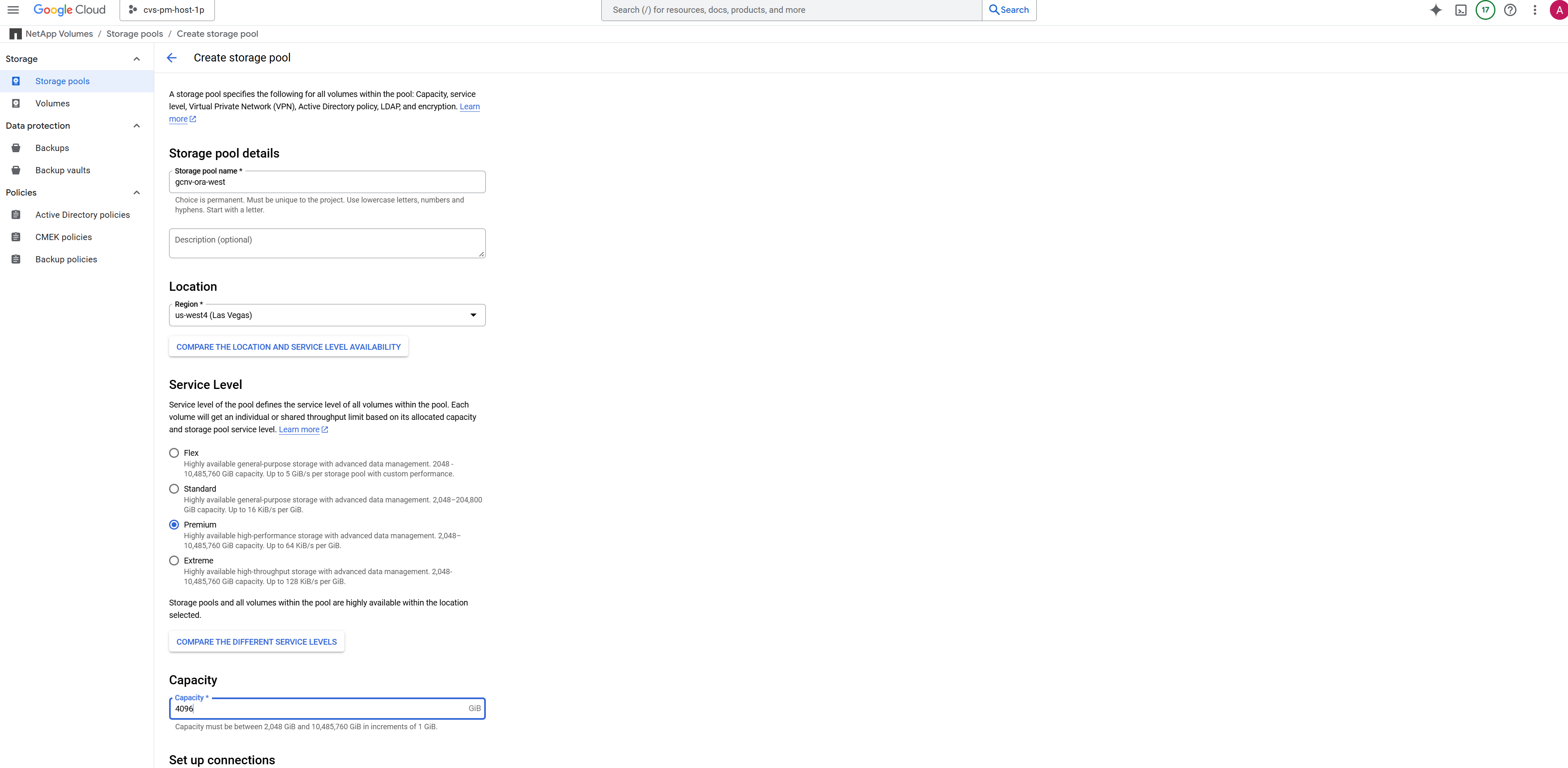
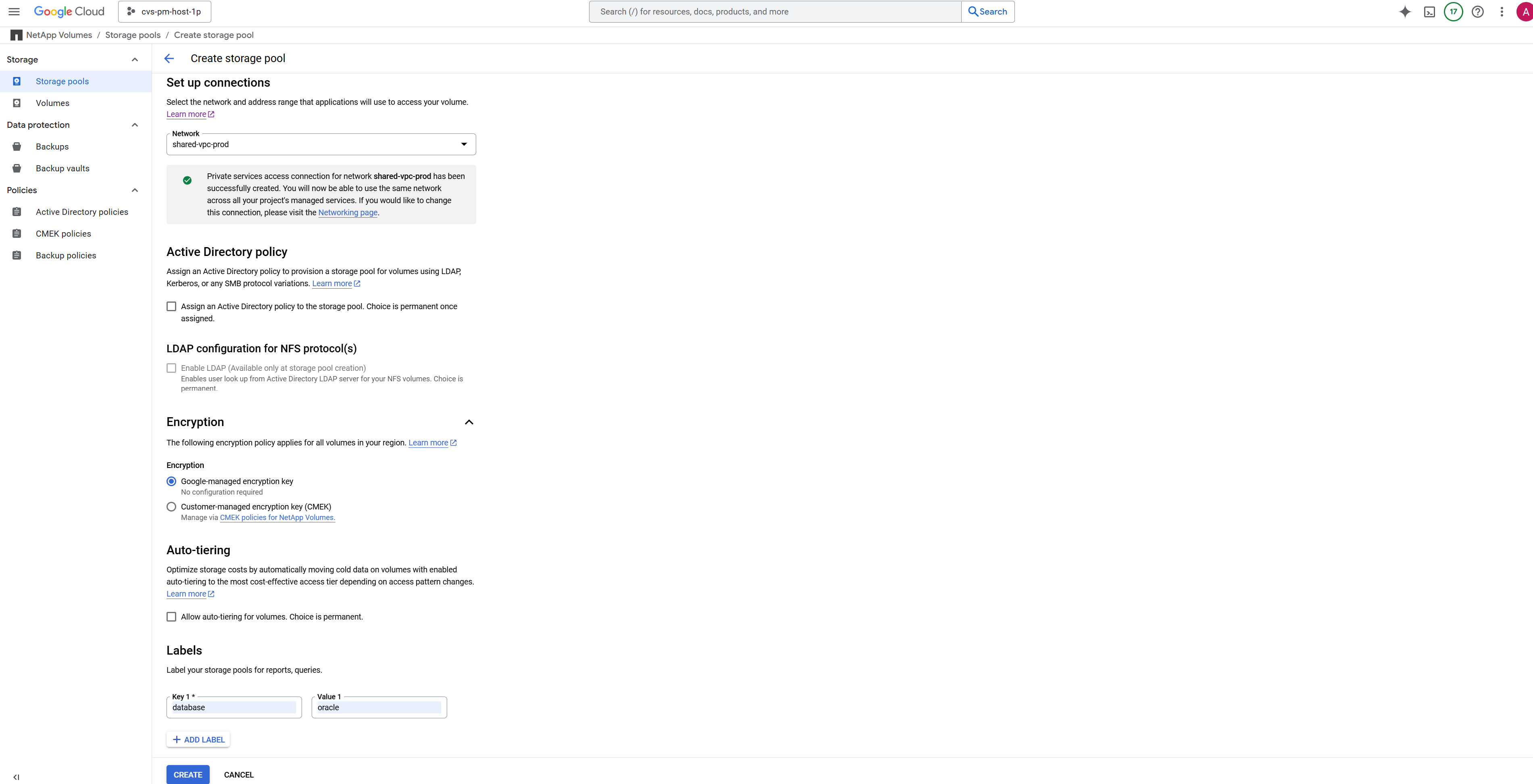

-
Create database volumes in storage pools. Referred to documentation Create a volume quickstart for step-by-step instructions. Following are some screen shots for quick reference.
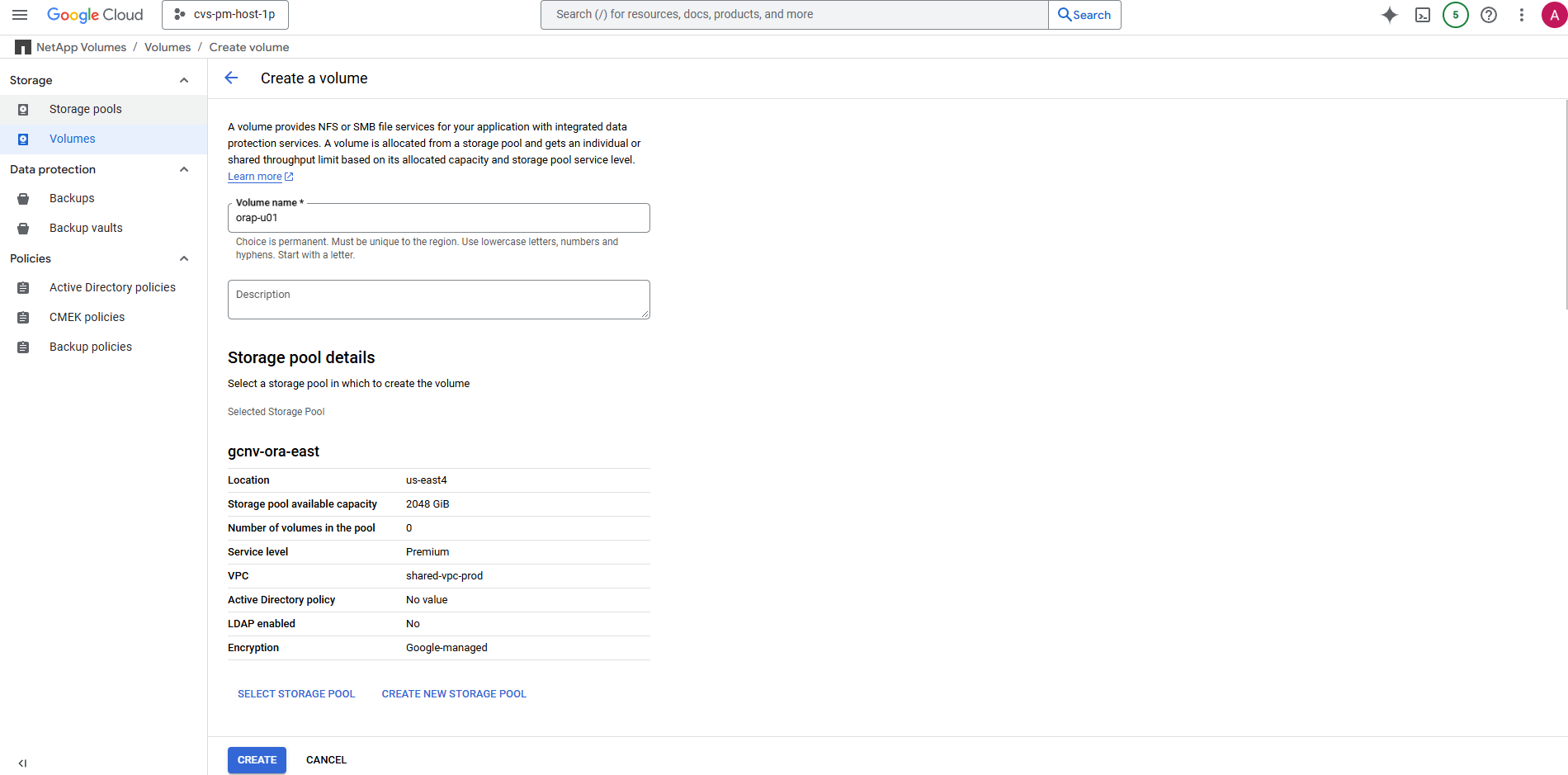
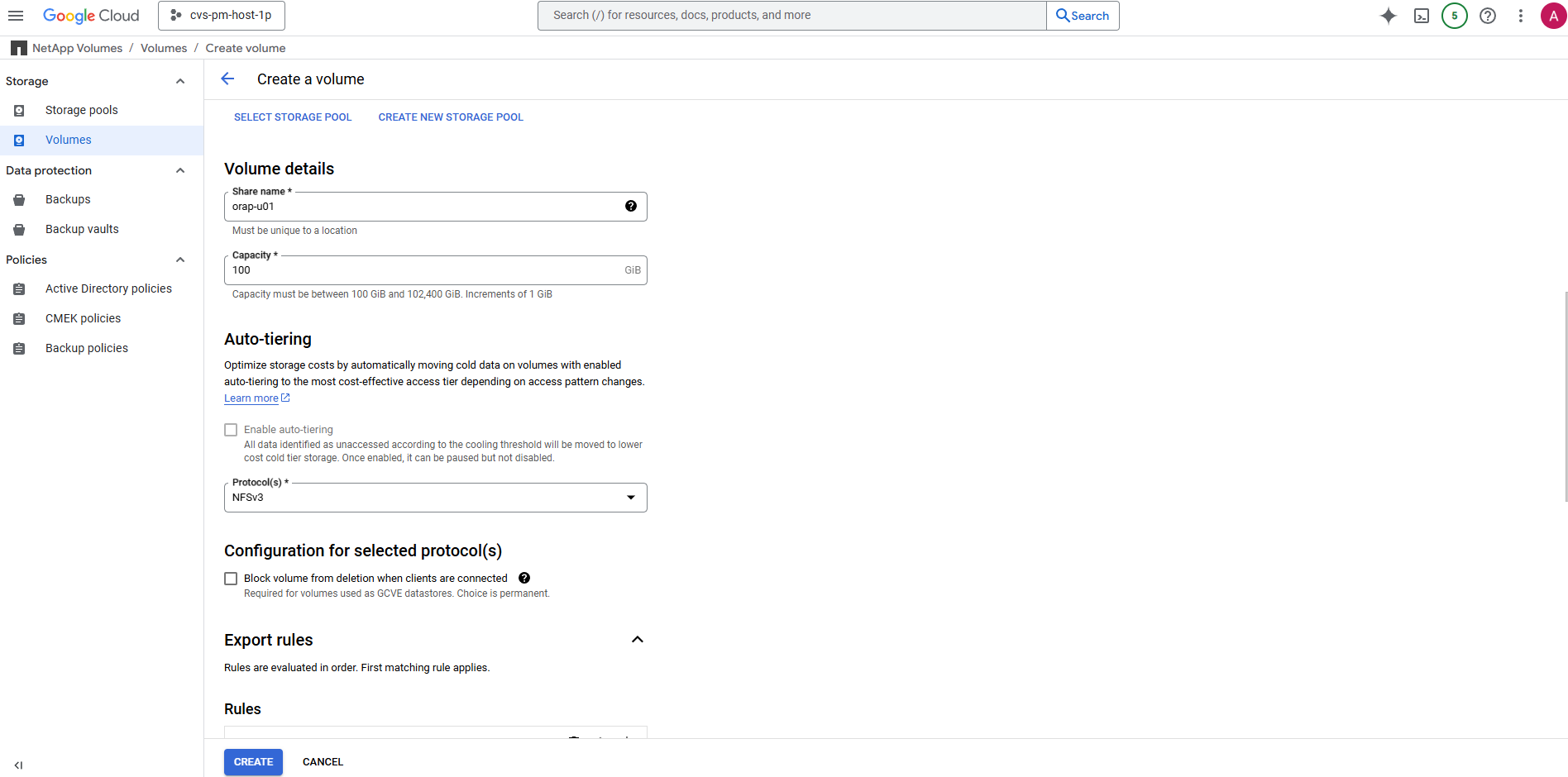
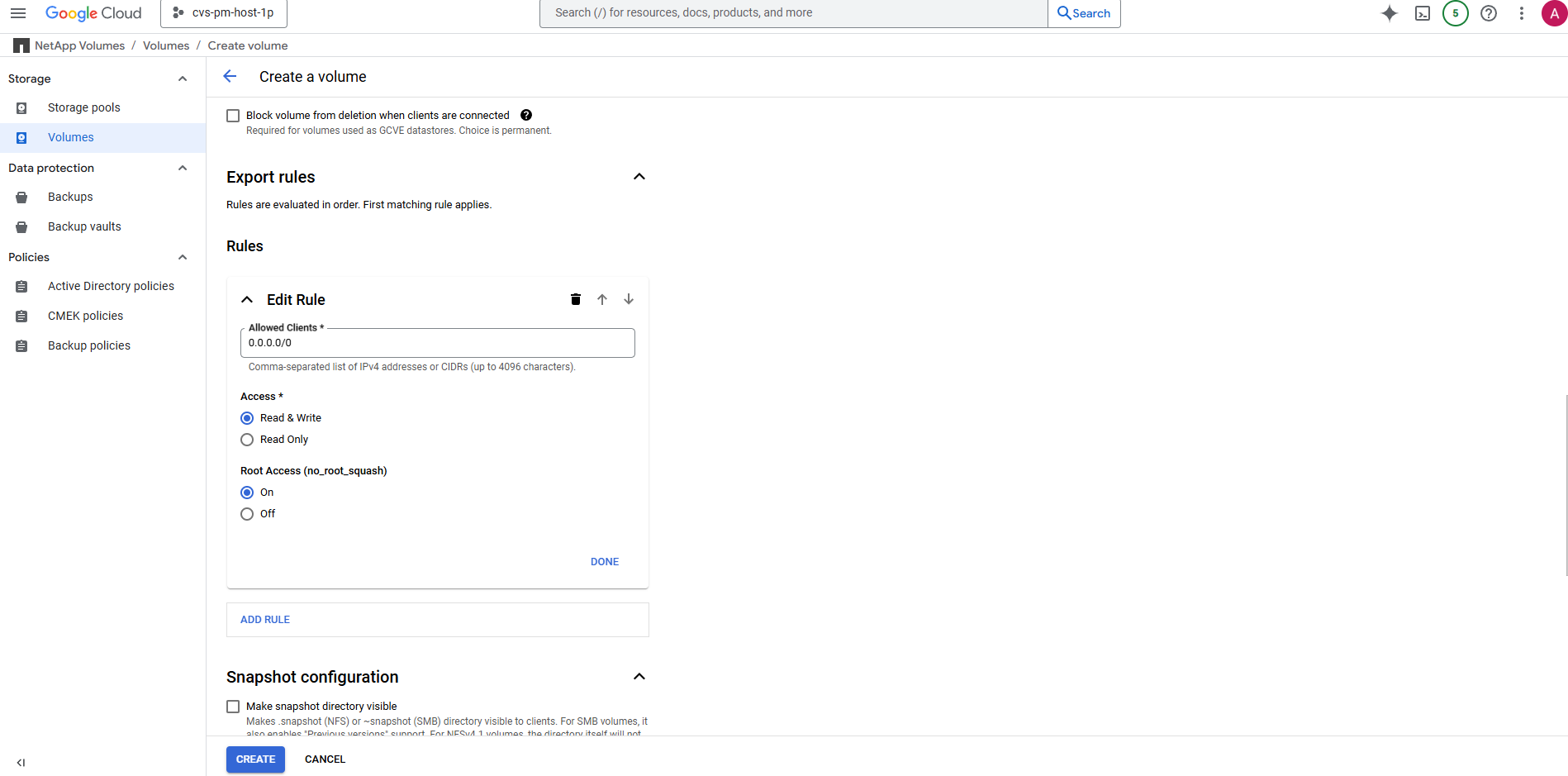
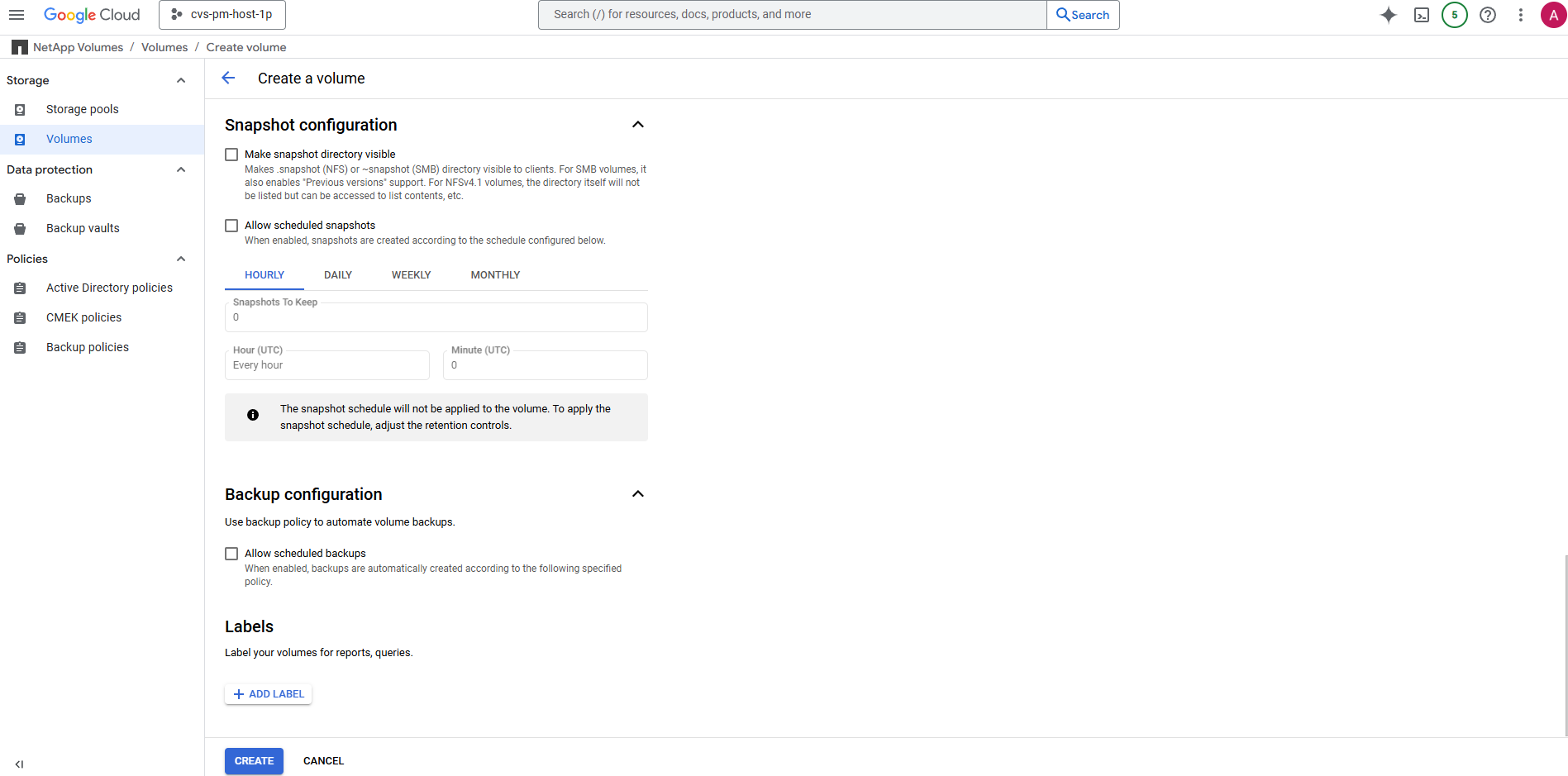
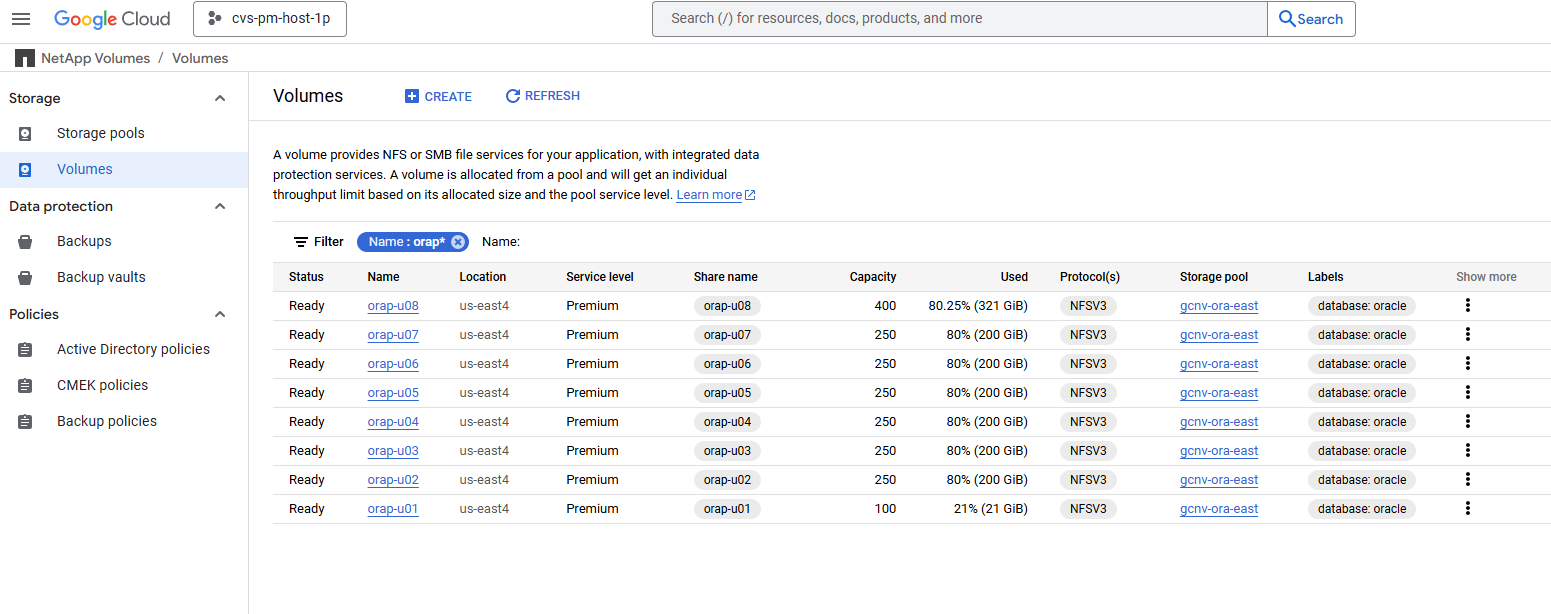
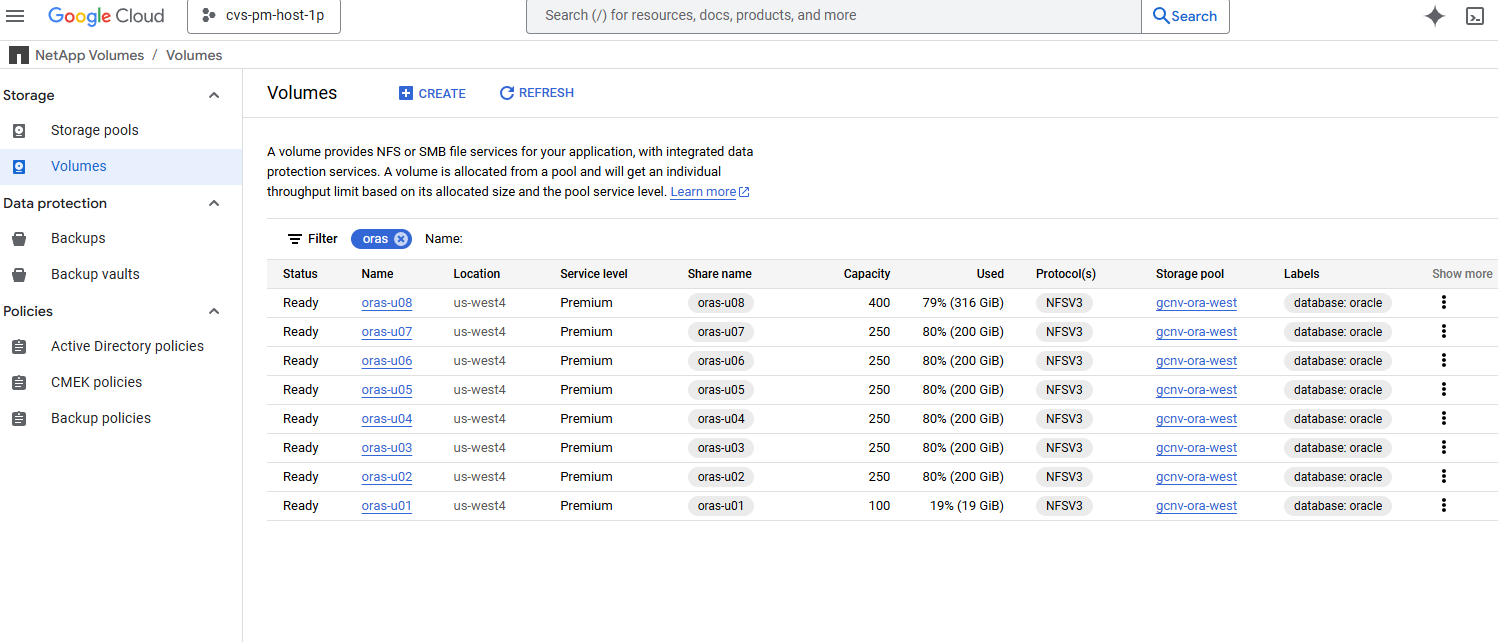
-
The primary Oracle database should have been installed and configured in the primary Oracle DB server. On the other hand, in the standby Oracle DB server or the clone Oracle DB server, only Oracle software is installed and no Oracle databases are created. Ideally, the Oracle files directories layout should be exactly matching on all Oracle DB servers. Refer to TR-4974 for help on Oracle grid infrastructure and database installation and configuration with NFS/ASM. Although the solution is validated on AWS FSx/EC2 environment, it can be equally applied to Google GCNV/Compute Engine environment.
Primary Oracle VLDB configuration for Data Guard
Details
In this demonstration, we have setup a primary Oracle database called NTAP on the primary DB server with eight NFS mount points: /u01 for the Oracle binary, /u02, /u03, /u04, /u05, /u06, /u07 for the Oracle data files, and load balanced with Oracle ASM disk group +DATA; /u08 for the Oracle active logs, archived log files, and load balanced with Oracle ASM disk group +LOGS. Oracle control files are placed on both +DATA and +LOGS disk groups for redundancy. This setup serves as a reference configuration. Your actual deployment should take into consideration of your specific needs and requirements in terms of the storage pool sizing, the service level, the number of database volumes and the sizing of each volume.
For detailed step by step procedures for setting up Oracle Data Guard on NFS with ASM, please referred to TR-5002 - Oracle Active Data Guard Cost Reduction with Azure NetApp Files. Although the procedures in TR-5002 were validated on Azure ANF environment, they are equally applicable to Google GCNV environment.
Following illustrates the details of a primary Oracle VLDB in a Data Guard configuration in Google GCNV environment.
-
The primary database NTAP in the primary compute engine DB server is deployed as a single instance database in a standalone Restart configuration on the GCNV storage with NFS protocol and ASM as database storage volume manager.
orap.us-east4-a.c.cvs-pm-host-1p.internal: Zone: us-east-4a size: n1-standard-4 (4 vCPUs, 15 GB Memory) OS: Linux (redhat 8.10) pub_ip: 35.212.124.14 pri_ip: 10.70.11.5 [oracle@orap ~]$ df -h Filesystem Size Used Avail Use% Mounted on devtmpfs 7.2G 0 7.2G 0% /dev tmpfs 7.3G 0 7.3G 0% /dev/shm tmpfs 7.3G 8.5M 7.2G 1% /run tmpfs 7.3G 0 7.3G 0% /sys/fs/cgroup /dev/sda2 50G 40G 11G 80% / /dev/sda1 200M 5.9M 194M 3% /boot/efi 10.165.128.180:/orap-u05 250G 201G 50G 81% /u05 10.165.128.180:/orap-u08 400G 322G 79G 81% /u08 10.165.128.180:/orap-u04 250G 201G 50G 81% /u04 10.165.128.180:/orap-u07 250G 201G 50G 81% /u07 10.165.128.180:/orap-u02 250G 201G 50G 81% /u02 10.165.128.180:/orap-u06 250G 201G 50G 81% /u06 10.165.128.180:/orap-u01 100G 21G 80G 21% /u01 10.165.128.180:/orap-u03 250G 201G 50G 81% /u03 [oracle@orap ~]$ cat /etc/oratab # # This file is used by ORACLE utilities. It is created by root.sh # and updated by either Database Configuration Assistant while creating # a database or ASM Configuration Assistant while creating ASM instance. # A colon, ':', is used as the field terminator. A new line terminates # the entry. Lines beginning with a pound sign, '#', are comments. # # Entries are of the form: # $ORACLE_SID:$ORACLE_HOME:<N|Y>: # # The first and second fields are the system identifier and home # directory of the database respectively. The third field indicates # to the dbstart utility that the database should , "Y", or should not, # "N", be brought up at system boot time. # # Multiple entries with the same $ORACLE_SID are not allowed. # # +ASM:/u01/app/oracle/product/19.0.0/grid:N NTAP:/u01/app/oracle/product/19.0.0/NTAP:N
-
Login to primary DB server as the oracle user. Validate grid configuration.
$GRID_HOME/bin/crsctl stat res -t[oracle@orap ~]$ $GRID_HOME/bin/crsctl stat res -t -------------------------------------------------------------------------------- Name Target State Server State details -------------------------------------------------------------------------------- Local Resources -------------------------------------------------------------------------------- ora.DATA.dg ONLINE ONLINE orap STABLE ora.LISTENER.lsnr ONLINE ONLINE orap STABLE ora.LOGS.dg ONLINE ONLINE orap STABLE ora.asm ONLINE ONLINE orap Started,STABLE ora.ons OFFLINE OFFLINE orap STABLE -------------------------------------------------------------------------------- Cluster Resources -------------------------------------------------------------------------------- ora.cssd 1 ONLINE ONLINE orap STABLE ora.diskmon 1 OFFLINE OFFLINE STABLE ora.evmd 1 ONLINE ONLINE orap STABLE ora.ntap.db 1 ONLINE ONLINE orap Open,HOME=/u01/app/o racle/product/19.0.0 /NTAP,STABLE -------------------------------------------------------------------------------- [oracle@orap ~]$ -
ASM disk group configuration.
asmcmd[oracle@orap ~]$ asmcmd ASMCMD> lsdg State Type Rebal Sector Logical_Sector Block AU Total_MB Free_MB Req_mir_free_MB Usable_file_MB Offline_disks Voting_files Name MOUNTED EXTERN N 512 512 4096 4194304 1228800 1219888 0 1219888 0 N DATA/ MOUNTED EXTERN N 512 512 4096 4194304 327680 326556 0 326556 0 N LOGS/ ASMCMD> lsdsk Path /u02/oradata/asm/orap_data_disk_01 /u02/oradata/asm/orap_data_disk_02 /u02/oradata/asm/orap_data_disk_03 /u02/oradata/asm/orap_data_disk_04 /u03/oradata/asm/orap_data_disk_05 /u03/oradata/asm/orap_data_disk_06 /u03/oradata/asm/orap_data_disk_07 /u03/oradata/asm/orap_data_disk_08 /u04/oradata/asm/orap_data_disk_09 /u04/oradata/asm/orap_data_disk_10 /u04/oradata/asm/orap_data_disk_11 /u04/oradata/asm/orap_data_disk_12 /u05/oradata/asm/orap_data_disk_13 /u05/oradata/asm/orap_data_disk_14 /u05/oradata/asm/orap_data_disk_15 /u05/oradata/asm/orap_data_disk_16 /u06/oradata/asm/orap_data_disk_17 /u06/oradata/asm/orap_data_disk_18 /u06/oradata/asm/orap_data_disk_19 /u06/oradata/asm/orap_data_disk_20 /u07/oradata/asm/orap_data_disk_21 /u07/oradata/asm/orap_data_disk_22 /u07/oradata/asm/orap_data_disk_23 /u07/oradata/asm/orap_data_disk_24 /u08/oralogs/asm/orap_logs_disk_01 /u08/oralogs/asm/orap_logs_disk_02 /u08/oralogs/asm/orap_logs_disk_03 /u08/oralogs/asm/orap_logs_disk_04 ASMCMD>
-
Parameters setting for Data Guard on primary DB.
SQL> show parameter name NAME TYPE VALUE ------------------------------------ ----------- ------------------------------ cdb_cluster_name string cell_offloadgroup_name string db_file_name_convert string db_name string ntap db_unique_name string ntap_ny global_names boolean FALSE instance_name string NTAP lock_name_space string log_file_name_convert string pdb_file_name_convert string processor_group_name string NAME TYPE VALUE ------------------------------------ ----------- ------------------------------ service_names string ntap_ny.cvs-pm-host-1p.interna SQL> sho parameter log_archive_dest NAME TYPE VALUE ------------------------------------ ----------- ------------------------------ log_archive_dest string log_archive_dest_1 string LOCATION=USE_DB_RECOVERY_FILE_ DEST VALID_FOR=(ALL_LOGFILES,A LL_ROLES) DB_UNIQUE_NAME=NTAP_ NY log_archive_dest_10 string log_archive_dest_11 string log_archive_dest_12 string log_archive_dest_13 string log_archive_dest_14 string log_archive_dest_15 string NAME TYPE VALUE ------------------------------------ ----------- ------------------------------ log_archive_dest_16 string log_archive_dest_17 string log_archive_dest_18 string log_archive_dest_19 string log_archive_dest_2 string SERVICE=NTAP_LA ASYNC VALID_FO R=(ONLINE_LOGFILES,PRIMARY_ROL E) DB_UNIQUE_NAME=NTAP_LA log_archive_dest_20 string log_archive_dest_21 string log_archive_dest_22 string -
Primary DB configuration.
SQL> select name, open_mode, log_mode from v$database; NAME OPEN_MODE LOG_MODE --------- -------------------- ------------ NTAP READ WRITE ARCHIVELOG SQL> show pdbs CON_ID CON_NAME OPEN MODE RESTRICTED ---------- ------------------------------ ---------- ---------- 2 PDB$SEED READ ONLY NO 3 NTAP_PDB1 READ WRITE NO 4 NTAP_PDB2 READ WRITE NO 5 NTAP_PDB3 READ WRITE NO SQL> select name from v$datafile; NAME -------------------------------------------------------------------------------- +DATA/NTAP/DATAFILE/system.257.1198026005 +DATA/NTAP/DATAFILE/sysaux.258.1198026051 +DATA/NTAP/DATAFILE/undotbs1.259.1198026075 +DATA/NTAP/86B637B62FE07A65E053F706E80A27CA/DATAFILE/system.266.1198027075 +DATA/NTAP/86B637B62FE07A65E053F706E80A27CA/DATAFILE/sysaux.267.1198027075 +DATA/NTAP/DATAFILE/users.260.1198026077 +DATA/NTAP/86B637B62FE07A65E053F706E80A27CA/DATAFILE/undotbs1.268.1198027075 +DATA/NTAP/32639B76C9BC91A8E063050B460A2116/DATAFILE/system.272.1198028157 +DATA/NTAP/32639B76C9BC91A8E063050B460A2116/DATAFILE/sysaux.273.1198028157 +DATA/NTAP/32639B76C9BC91A8E063050B460A2116/DATAFILE/undotbs1.271.1198028157 +DATA/NTAP/32639B76C9BC91A8E063050B460A2116/DATAFILE/users.275.1198028185 NAME -------------------------------------------------------------------------------- +DATA/NTAP/32639D40D02D925FE063050B460A60E3/DATAFILE/system.277.1198028187 +DATA/NTAP/32639D40D02D925FE063050B460A60E3/DATAFILE/sysaux.278.1198028187 +DATA/NTAP/32639D40D02D925FE063050B460A60E3/DATAFILE/undotbs1.276.1198028187 +DATA/NTAP/32639D40D02D925FE063050B460A60E3/DATAFILE/users.280.1198028209 +DATA/NTAP/32639E973AF79299E063050B460AFBAD/DATAFILE/system.282.1198028209 +DATA/NTAP/32639E973AF79299E063050B460AFBAD/DATAFILE/sysaux.283.1198028209 +DATA/NTAP/32639E973AF79299E063050B460AFBAD/DATAFILE/undotbs1.281.1198028209 +DATA/NTAP/32639E973AF79299E063050B460AFBAD/DATAFILE/users.285.1198028229 19 rows selected. SQL> select member from v$logfile; MEMBER -------------------------------------------------------------------------------- +DATA/NTAP/ONLINELOG/group_3.264.1198026139 +LOGS/NTAP/ONLINELOG/group_3.259.1198026147 +DATA/NTAP/ONLINELOG/group_2.263.1198026137 +LOGS/NTAP/ONLINELOG/group_2.258.1198026145 +DATA/NTAP/ONLINELOG/group_1.262.1198026137 +LOGS/NTAP/ONLINELOG/group_1.257.1198026145 +DATA/NTAP/ONLINELOG/group_4.286.1198511423 +LOGS/NTAP/ONLINELOG/group_4.265.1198511425 +DATA/NTAP/ONLINELOG/group_5.287.1198511445 +LOGS/NTAP/ONLINELOG/group_5.266.1198511447 +DATA/NTAP/ONLINELOG/group_6.288.1198511459 MEMBER -------------------------------------------------------------------------------- +LOGS/NTAP/ONLINELOG/group_6.267.1198511461 +DATA/NTAP/ONLINELOG/group_7.289.1198511477 +LOGS/NTAP/ONLINELOG/group_7.268.1198511479 14 rows selected. SQL> select name from v$controlfile; NAME -------------------------------------------------------------------------------- +DATA/NTAP/CONTROLFILE/current.261.1198026135 +LOGS/NTAP/CONTROLFILE/current.256.1198026135 -
Oracle listener configuration.
lsnrctl status listener[oracle@orap admin]$ lsnrctl status LSNRCTL for Linux: Version 19.0.0.0.0 - Production on 15-APR-2025 16:14:00 Copyright (c) 1991, 2022, Oracle. All rights reserved. Connecting to (ADDRESS=(PROTOCOL=tcp)(HOST=)(PORT=1521)) STATUS of the LISTENER ------------------------ Alias LISTENER Version TNSLSNR for Linux: Version 19.0.0.0.0 - Production Start Date 14-APR-2025 19:44:21 Uptime 0 days 20 hr. 29 min. 38 sec Trace Level off Security ON: Local OS Authentication SNMP OFF Listener Parameter File /u01/app/oracle/product/19.0.0/grid/network/admin/listener.ora Listener Log File /u01/app/oracle/diag/tnslsnr/orap/listener/alert/log.xml Listening Endpoints Summary... (DESCRIPTION=(ADDRESS=(PROTOCOL=tcp)(HOST=orap.us-east4-a.c.cvs-pm-host-1p.internal)(PORT=1521))) (DESCRIPTION=(ADDRESS=(PROTOCOL=ipc)(KEY=EXTPROC1521))) Services Summary... Service "+ASM" has 1 instance(s). Instance "+ASM", status READY, has 1 handler(s) for this service... Service "+ASM_DATA" has 1 instance(s). Instance "+ASM", status READY, has 1 handler(s) for this service... Service "+ASM_LOGS" has 1 instance(s). Instance "+ASM", status READY, has 1 handler(s) for this service... Service "32639b76c9bc91a8e063050b460a2116.cvs-pm-host-1p.internal" has 1 instance(s). Instance "NTAP", status READY, has 1 handler(s) for this service... Service "32639d40d02d925fe063050b460a60e3.cvs-pm-host-1p.internal" has 1 instance(s). Instance "NTAP", status READY, has 1 handler(s) for this service... Service "32639e973af79299e063050b460afbad.cvs-pm-host-1p.internal" has 1 instance(s). Instance "NTAP", status READY, has 1 handler(s) for this service... Service "86b637b62fdf7a65e053f706e80a27ca.cvs-pm-host-1p.internal" has 1 instance(s). Instance "NTAP", status READY, has 1 handler(s) for this service... Service "NTAPXDB.cvs-pm-host-1p.internal" has 1 instance(s). Instance "NTAP", status READY, has 1 handler(s) for this service... Service "NTAP_NY_DGMGRL.cvs-pm-host-1p.internal" has 1 instance(s). Instance "NTAP", status UNKNOWN, has 1 handler(s) for this service... Service "ntap.cvs-pm-host-1p.internal" has 1 instance(s). Instance "NTAP", status READY, has 1 handler(s) for this service... Service "ntap_pdb1.cvs-pm-host-1p.internal" has 1 instance(s). Instance "NTAP", status READY, has 1 handler(s) for this service... Service "ntap_pdb2.cvs-pm-host-1p.internal" has 1 instance(s). Instance "NTAP", status READY, has 1 handler(s) for this service... Service "ntap_pdb3.cvs-pm-host-1p.internal" has 1 instance(s). Instance "NTAP", status READY, has 1 handler(s) for this service... The command completed successfully
-
Flashback is enabled at primary database.
SQL> select name, database_role, flashback_on from v$database; NAME DATABASE_ROLE FLASHBACK_ON --------- ---------------- ------------------ NTAP PRIMARY YES
-
dNFS configuration on primary DB.
SQL> select svrname, dirname from v$dnfs_servers; SVRNAME -------------------------------------------------------------------------------- DIRNAME -------------------------------------------------------------------------------- 10.165.128.180 /orap-u04 10.165.128.180 /orap-u05 10.165.128.180 /orap-u07 SVRNAME -------------------------------------------------------------------------------- DIRNAME -------------------------------------------------------------------------------- 10.165.128.180 /orap-u03 10.165.128.180 /orap-u06 10.165.128.180 /orap-u02 SVRNAME -------------------------------------------------------------------------------- DIRNAME -------------------------------------------------------------------------------- 10.165.128.180 /orap-u08 10.165.128.180 /orap-u01 8 rows selected.
This completes the demonstration of a Data Guard setup for VLDB NTAP at the primary site on GCNV with NFS/ASM.
Standby Oracle VLDB configuration for Data Guard
Details
Oracle Data Guard requires OS kernel configuration and Oracle software stacks including patch sets on standby DB server to match with primary DB server. For easy management and simplicity, the database storage configuration of the standby DB server ideally should match with the primary DB server as well, such as the database directory layout and sizes of NFS mount points.
Again, for detailed step by step procedures for setting up Oracle Data Guard standby on NFS with ASM, please refer to TR-5002 - Oracle Active Data Guard Cost Reduction with Azure NetApp Files and TR-4974 - Oracle 19c in Standalone Restart on AWS FSx/EC2 with NFS/ASM relevant sections. Following illustrates the detail of standby Oracle VLDB configuration on standby DB server in a Data Guard setting in Google GCNV environment.
-
The standby Oracle DB server configuration at standby site in the demo lab.
oras.us-west4-a.c.cvs-pm-host-1p.internal: Zone: us-west4-a size: n1-standard-4 (4 vCPUs, 15 GB Memory) OS: Linux (redhat 8.10) pub_ip: 35.219.129.195 pri_ip: 10.70.14.16 [oracle@oras ~]$ df -h Filesystem Size Used Avail Use% Mounted on devtmpfs 7.2G 0 7.2G 0% /dev tmpfs 7.3G 1.1G 6.2G 16% /dev/shm tmpfs 7.3G 8.5M 7.2G 1% /run tmpfs 7.3G 0 7.3G 0% /sys/fs/cgroup /dev/sda2 50G 40G 11G 80% / /dev/sda1 200M 5.9M 194M 3% /boot/efi 10.165.128.197:/oras-u07 250G 201G 50G 81% /u07 10.165.128.197:/oras-u06 250G 201G 50G 81% /u06 10.165.128.197:/oras-u02 250G 201G 50G 81% /u02 10.165.128.196:/oras-u03 250G 201G 50G 81% /u03 10.165.128.196:/oras-u01 100G 20G 81G 20% /u01 10.165.128.197:/oras-u05 250G 201G 50G 81% /u05 10.165.128.197:/oras-u04 250G 201G 50G 81% /u04 10.165.128.197:/oras-u08 400G 317G 84G 80% /u08 [oracle@oras ~]$ cat /etc/oratab #Backup file is /u01/app/oracle/crsdata/oras/output/oratab.bak.oras.oracle line added by Agent # # This file is used by ORACLE utilities. It is created by root.sh # and updated by either Database Configuration Assistant while creating # a database or ASM Configuration Assistant while creating ASM instance. # A colon, ':', is used as the field terminator. A new line terminates # the entry. Lines beginning with a pound sign, '#', are comments. # # Entries are of the form: # $ORACLE_SID:$ORACLE_HOME:<N|Y>: # # The first and second fields are the system identifier and home # directory of the database respectively. The third field indicates # to the dbstart utility that the database should , "Y", or should not, # "N", be brought up at system boot time. # # Multiple entries with the same $ORACLE_SID are not allowed. # # +ASM:/u01/app/oracle/product/19.0.0/grid:N NTAP:/u01/app/oracle/product/19.0.0/NTAP:N # line added by Agent
-
Grid infrastructure configuration on standby DB server.
[oracle@oras ~]$ $GRID_HOME/bin/crsctl stat res -t -------------------------------------------------------------------------------- Name Target State Server State details -------------------------------------------------------------------------------- Local Resources -------------------------------------------------------------------------------- ora.DATA.dg ONLINE ONLINE oras STABLE ora.LISTENER.lsnr ONLINE ONLINE oras STABLE ora.LOGS.dg ONLINE ONLINE oras STABLE ora.asm ONLINE ONLINE oras Started,STABLE ora.ons OFFLINE OFFLINE oras STABLE -------------------------------------------------------------------------------- Cluster Resources -------------------------------------------------------------------------------- ora.cssd 1 ONLINE ONLINE oras STABLE ora.diskmon 1 OFFLINE OFFLINE STABLE ora.evmd 1 ONLINE ONLINE oras STABLE ora.ntap_la.db 1 ONLINE INTERMEDIATE oras Dismounted,Mount Ini tiated,HOME=/u01/app /oracle/product/19.0 .0/NTAP,STABLE -------------------------------------------------------------------------------- -
ASM disk groups configuration on standby DB server.
[oracle@oras ~]$ asmcmd ASMCMD> lsdg State Type Rebal Sector Logical_Sector Block AU Total_MB Free_MB Req_mir_free_MB Usable_file_MB Offline_disks Voting_files Name MOUNTED EXTERN N 512 512 4096 4194304 1228800 1228420 0 1228420 0 N DATA/ MOUNTED EXTERN N 512 512 4096 4194304 322336 322204 0 322204 0 N LOGS/ ASMCMD> lsdsk Path /u02/oradata/asm/oras_data_disk_01 /u02/oradata/asm/oras_data_disk_02 /u02/oradata/asm/oras_data_disk_03 /u02/oradata/asm/oras_data_disk_04 /u03/oradata/asm/oras_data_disk_05 /u03/oradata/asm/oras_data_disk_06 /u03/oradata/asm/oras_data_disk_07 /u03/oradata/asm/oras_data_disk_08 /u04/oradata/asm/oras_data_disk_09 /u04/oradata/asm/oras_data_disk_10 /u04/oradata/asm/oras_data_disk_11 /u04/oradata/asm/oras_data_disk_12 /u05/oradata/asm/oras_data_disk_13 /u05/oradata/asm/oras_data_disk_14 /u05/oradata/asm/oras_data_disk_15 /u05/oradata/asm/oras_data_disk_16 /u06/oradata/asm/oras_data_disk_17 /u06/oradata/asm/oras_data_disk_18 /u06/oradata/asm/oras_data_disk_19 /u06/oradata/asm/oras_data_disk_20 /u07/oradata/asm/oras_data_disk_21 /u07/oradata/asm/oras_data_disk_22 /u07/oradata/asm/oras_data_disk_23 /u07/oradata/asm/oras_data_disk_24 /u08/oralogs/asm/oras_logs_disk_01 /u08/oralogs/asm/oras_logs_disk_02 /u08/oralogs/asm/oras_logs_disk_03 /u08/oralogs/asm/oras_logs_disk_04 ASMCMD>
-
Parameters setting for Data Guard on standby DB.
SQL> show parameter name NAME TYPE VALUE ------------------------------------ ----------- ------------------------------ cdb_cluster_name string cell_offloadgroup_name string db_file_name_convert string db_name string NTAP db_unique_name string NTAP_LA global_names boolean FALSE instance_name string NTAP lock_name_space string log_file_name_convert string pdb_file_name_convert string processor_group_name string NAME TYPE VALUE ------------------------------------ ----------- ------------------------------ service_names string NTAP_LA.cvs-pm-host-1p.interna l SQL> show parameter log_archive_config NAME TYPE VALUE ------------------------------------ ----------- ------------------------------ log_archive_config string DG_CONFIG=(NTAP_NY,NTAP_LA) SQL> show parameter fal_server NAME TYPE VALUE ------------------------------------ ----------- ------------------------------ fal_server string NTAP_NY -
Standby DB configuration.
SQL> select name, open_mode, log_mode from v$database; NAME OPEN_MODE LOG_MODE --------- -------------------- ------------ NTAP MOUNTED ARCHIVELOG SQL> show pdbs CON_ID CON_NAME OPEN MODE RESTRICTED ---------- ------------------------------ ---------- ---------- 2 PDB$SEED MOUNTED 3 NTAP_PDB1 MOUNTED 4 NTAP_PDB2 MOUNTED 5 NTAP_PDB3 MOUNTED SQL> select name from v$datafile; NAME -------------------------------------------------------------------------------- +DATA/NTAP_LA/DATAFILE/system.261.1198520347 +DATA/NTAP_LA/DATAFILE/sysaux.262.1198520373 +DATA/NTAP_LA/DATAFILE/undotbs1.263.1198520399 +DATA/NTAP_LA/32635CC1DCF58A60E063050B460AB746/DATAFILE/system.264.1198520417 +DATA/NTAP_LA/32635CC1DCF58A60E063050B460AB746/DATAFILE/sysaux.265.1198520435 +DATA/NTAP_LA/DATAFILE/users.266.1198520451 +DATA/NTAP_LA/32635CC1DCF58A60E063050B460AB746/DATAFILE/undotbs1.267.1198520455 +DATA/NTAP_LA/32639B76C9BC91A8E063050B460A2116/DATAFILE/system.268.1198520471 +DATA/NTAP_LA/32639B76C9BC91A8E063050B460A2116/DATAFILE/sysaux.269.1198520489 +DATA/NTAP_LA/32639B76C9BC91A8E063050B460A2116/DATAFILE/undotbs1.270.1198520505 +DATA/NTAP_LA/32639B76C9BC91A8E063050B460A2116/DATAFILE/users.271.1198520513 NAME -------------------------------------------------------------------------------- +DATA/NTAP_LA/32639D40D02D925FE063050B460A60E3/DATAFILE/system.272.1198520517 +DATA/NTAP_LA/32639D40D02D925FE063050B460A60E3/DATAFILE/sysaux.273.1198520533 +DATA/NTAP_LA/32639D40D02D925FE063050B460A60E3/DATAFILE/undotbs1.274.1198520551 +DATA/NTAP_LA/32639D40D02D925FE063050B460A60E3/DATAFILE/users.275.1198520559 +DATA/NTAP_LA/32639E973AF79299E063050B460AFBAD/DATAFILE/system.276.1198520563 +DATA/NTAP_LA/32639E973AF79299E063050B460AFBAD/DATAFILE/sysaux.277.1198520579 +DATA/NTAP_LA/32639E973AF79299E063050B460AFBAD/DATAFILE/undotbs1.278.1198520595 +DATA/NTAP_LA/32639E973AF79299E063050B460AFBAD/DATAFILE/users.279.1198520605 19 rows selected. SQL> select name from v$controlfile; NAME -------------------------------------------------------------------------------- +DATA/NTAP_LA/CONTROLFILE/current.260.1198520303 +LOGS/NTAP_LA/CONTROLFILE/current.257.1198520305 SQL> select group#, type, member from v$logfile order by 2, 1; GROUP# TYPE MEMBER ---------- ------- ------------------------------------------------------------ 1 ONLINE +DATA/NTAP_LA/ONLINELOG/group_1.280.1198520649 1 ONLINE +LOGS/NTAP_LA/ONLINELOG/group_1.259.1198520651 2 ONLINE +DATA/NTAP_LA/ONLINELOG/group_2.281.1198520659 2 ONLINE +LOGS/NTAP_LA/ONLINELOG/group_2.258.1198520661 3 ONLINE +DATA/NTAP_LA/ONLINELOG/group_3.282.1198520669 3 ONLINE +LOGS/NTAP_LA/ONLINELOG/group_3.260.1198520671 4 STANDBY +DATA/NTAP_LA/ONLINELOG/group_4.283.1198520677 4 STANDBY +LOGS/NTAP_LA/ONLINELOG/group_4.261.1198520679 5 STANDBY +DATA/NTAP_LA/ONLINELOG/group_5.284.1198520687 5 STANDBY +LOGS/NTAP_LA/ONLINELOG/group_5.262.1198520689 6 STANDBY +DATA/NTAP_LA/ONLINELOG/group_6.285.1198520697 GROUP# TYPE MEMBER ---------- ------- ------------------------------------------------------------ 6 STANDBY +LOGS/NTAP_LA/ONLINELOG/group_6.263.1198520699 7 STANDBY +DATA/NTAP_LA/ONLINELOG/group_7.286.1198520707 7 STANDBY +LOGS/NTAP_LA/ONLINELOG/group_7.264.1198520709 14 rows selected. -
Validate the standby database recovery status. Notice the
recovery logmergerinAPPLYING_LOGaction.SQL> SELECT ROLE, THREAD#, SEQUENCE#, ACTION FROM V$DATAGUARD_PROCESS; ROLE THREAD# SEQUENCE# ACTION ------------------------ ---------- ---------- ------------ post role transition 0 0 IDLE recovery apply slave 0 0 IDLE recovery apply slave 0 0 IDLE recovery apply slave 0 0 IDLE recovery apply slave 0 0 IDLE recovery logmerger 1 24 APPLYING_LOG managed recovery 0 0 IDLE RFS ping 1 24 IDLE archive redo 0 0 IDLE archive redo 0 0 IDLE gap manager 0 0 IDLE ROLE THREAD# SEQUENCE# ACTION ------------------------ ---------- ---------- ------------ archive local 0 0 IDLE redo transport timer 0 0 IDLE archive redo 0 0 IDLE RFS async 1 24 IDLE redo transport monitor 0 0 IDLE log writer 0 0 IDLE 17 rows selected.
-
Flashback is enabled at standby database.
SQL> select name, database_role, flashback_on from v$database; NAME DATABASE_ROLE FLASHBACK_ON --------- ---------------- ------------------ NTAP PHYSICAL STANDBY YES
-
dNFS configuration on standby DB.
SQL> select svrname, dirname from v$dnfs_servers; SVRNAME -------------------------------------------------------------------------------- DIRNAME -------------------------------------------------------------------------------- 10.165.128.197 /oras-u04 10.165.128.197 /oras-u05 10.165.128.197 /oras-u06 10.165.128.197 /oras-u07 10.165.128.197 /oras-u02 10.165.128.197 /oras-u08 10.165.128.196 /oras-u03 10.165.128.196 /oras-u01 8 rows selected.
This completes the demonstration of a Data Guard setup for VLDB NTAP with managed standby recovery enabled at standby site.
Setup Data Guard Broker and FSFO with an Observer
Setup Data Guard Broker
Details
Oracle Data Guard broker is a distributed management framework that automates and centralizes the creation, maintenance, and monitoring of Oracle Data Guard configurations. Following section demonstrate how to setup Data Guard Broker to manage Data Guard environment.
-
Start data guard broker on both the primary and the standby databases with following command via sqlplus.
alter system set dg_broker_start=true scope=both; -
From primary database, connect to Data Guard Borker as SYSDBA.
[oracle@orap ~]$ dgmgrl sys@NTAP_NY DGMGRL for Linux: Release 19.0.0.0.0 - Production on Wed Dec 11 20:53:20 2024 Version 19.18.0.0.0 Copyright (c) 1982, 2019, Oracle and/or its affiliates. All rights reserved. Welcome to DGMGRL, type "help" for information. Password: Connected to "NTAP_NY" Connected as SYSDBA. DGMGRL>
-
Create and enable Data Guard Broker configuration.
DGMGRL> create configuration dg_config as primary database is NTAP_NY connect identifier is NTAP_NY; Configuration "dg_config" created with primary database "ntap_ny" DGMGRL> add database NTAP_LA as connect identifier is NTAP_LA; Database "ntap_la" added DGMGRL> enable configuration; Enabled. DGMGRL> show configuration; Configuration - dg_config Protection Mode: MaxPerformance Members: ntap_ny - Primary database ntap_la - Physical standby database Fast-Start Failover: Disabled Configuration Status: SUCCESS (status updated 3 seconds ago) -
Validate the database status within the Data Guard Broker management framework.
DGMGRL> show database ntap_ny; Database - ntap_ny Role: PRIMARY Intended State: TRANSPORT-ON Instance(s): NTAP Database Status: SUCCESS DGMGRL> show database ntap_la; Database - ntap_la Role: PHYSICAL STANDBY Intended State: APPLY-ON Transport Lag: 0 seconds (computed 0 seconds ago) Apply Lag: 0 seconds (computed 0 seconds ago) Average Apply Rate: 3.00 KByte/s Real Time Query: OFF Instance(s): NTAP Database Status: SUCCESS DGMGRL>
In the event of a failure, Data Guard Broker can be used to failover the primary database to the standby instantaniouly. If Fast-Start Failover is enabled, Data Guard Broker can failover the primary database to the standby when a failure is detected without an user intervention.
Configure FSFO with an Observer
Details
Optionally, Fast Start Fail Over (FSFO) can be enabled for Data Guard Broker to failover the primary database to standby database in the event of a failure automatically. Following are the procedures to setup FSFO with an observer instance.
-
Create a lightweight Google compute engine instance to run Observer in a different zone than primary or standby DB server. In the test case, we used a N1 instance with 2 vCPU with 7.5G memory. Have same version of Oracle installed on the host.
-
Login in as oracle user and set oracle environment in the oracle user .bash_profile.
vi ~/.bash_profile# .bash_profile # Get the aliases and functions if [ -f ~/.bashrc ]; then . ~/.bashrc fi # User specific environment and startup programs export ORACLE_HOME=/u01/app/oracle/product/19.0.0/NTAP export PATH=$ORACLE_HOME/bin:$PATH -
Add primary and standby DB TNS name entries to tnsname.ora file.
vi $ORACLE_HOME/network/admin/tsnames.oraNTAP_NY = (DESCRIPTION = (ADDRESS = (PROTOCOL = TCP)(HOST = orap.us-east4-a.c.cvs-pm-host-1p.internal)(PORT = 1521)) (CONNECT_DATA = (SERVER = DEDICATED) (SERVICE_NAME = NTAP_NY.cvs-pm-host-1p.internal) (UR=A) ) ) NTAP_LA = (DESCRIPTION = (ADDRESS = (PROTOCOL = TCP)(HOST = oras.us-west4-a.c.cvs-pm-host-1p.internal)(PORT = 1521)) (CONNECT_DATA = (SERVER = DEDICATED) (SERVICE_NAME = NTAP_LA.cvs-pm-host-1p.internal) (UR=A) ) ) -
Create and initialize wallet with a password.
mkdir -p /u01/app/oracle/admin/NTAP/walletmkstore -wrl /u01/app/oracle/admin/NTAP/wallet -create[oracle@orao NTAP]$ mkdir -p /u01/app/oracle/admin/NTAP/wallet [oracle@orao NTAP]$ mkstore -wrl /u01/app/oracle/admin/NTAP/wallet -create Oracle Secret Store Tool Release 19.0.0.0.0 - Production Version 19.4.0.0.0 Copyright (c) 2004, 2022, Oracle and/or its affiliates. All rights reserved. Enter password: Enter password again: [oracle@orao NTAP]$
-
Enable passwordless authentication for user sys of both primary and standby database. Enter sys password first, then wallet password from previous step.
mkstore -wrl /u01/app/oracle/admin/NTAP/wallet -createCredential NTAP_NY sys
mkstore -wrl /u01/app/oracle/admin/NTAP/wallet -createCredential NTAP_LA sys
[oracle@orao NTAP]$ mkstore -wrl /u01/app/oracle/admin/NTAP/wallet -createCredential NTAP_NY sys Oracle Secret Store Tool Release 19.0.0.0.0 - Production Version 19.4.0.0.0 Copyright (c) 2004, 2022, Oracle and/or its affiliates. All rights reserved. Your secret/Password is missing in the command line Enter your secret/Password: Re-enter your secret/Password: Enter wallet password: [oracle@orao NTAP]$ mkstore -wrl /u01/app/oracle/admin/NTAP/wallet -createCredential NTAP_LA sys Oracle Secret Store Tool Release 19.0.0.0.0 - Production Version 19.4.0.0.0 Copyright (c) 2004, 2022, Oracle and/or its affiliates. All rights reserved. Your secret/Password is missing in the command line Enter your secret/Password: Re-enter your secret/Password: Enter wallet password: [oracle@orao NTAP]$
-
Update sqlnet.ora with wallet location.
vi $ORACLE_HOME/network/admin/sqlnet.oraWALLET_LOCATION = (SOURCE = (METHOD = FILE) (METHOD_DATA = (DIRECTORY = /u01/app/oracle/admin/NTAP/wallet)) ) SQLNET.WALLET_OVERRIDE = TRUE -
Validate the crentials.
mkstore -wrl /u01/app/oracle/admin/NTAP/wallet -listCredentialsqlplus /@NTAP_LA as sysdbasqlplus /@NTAP_NY as sysdba[oracle@orao NTAP]$ mkstore -wrl /u01/app/oracle/admin/NTAP/wallet -listCredential Oracle Secret Store Tool Release 19.0.0.0.0 - Production Version 19.4.0.0.0 Copyright (c) 2004, 2022, Oracle and/or its affiliates. All rights reserved. Enter wallet password: List credential (index: connect_string username) 2: NTAP_LA sys 1: NTAP_NY sys
-
Configure and enable Fast-Start Failover.
mkdir /u01/app/oracle/admin/NTAP/fsfodgmgrlWelcome to DGMGRL, type "help" for information. DGMGRL> connect /@NTAP_NY Connected to "ntap_ny" Connected as SYSDBA. DGMGRL> show configuration; Configuration - dg_config Protection Mode: MaxAvailability Members: ntap_ny - Primary database ntap_la - Physical standby database Fast-Start Failover: Disabled Configuration Status: SUCCESS (status updated 58 seconds ago) DGMGRL> enable fast_start failover; Enabled in Zero Data Loss Mode. DGMGRL> show configuration; Configuration - dg_config Protection Mode: MaxAvailability Members: ntap_ny - Primary database Warning: ORA-16819: fast-start failover observer not started ntap_la - (*) Physical standby database Fast-Start Failover: Enabled in Zero Data Loss Mode Configuration Status: WARNING (status updated 43 seconds ago) -
Start and validate observer.
nohup dgmgrl /@NTAP_NY "start observer file='/u01/app/oracle/admin/NTAP/fsfo/fsfo.dat'" >> /u01/app/oracle/admin/NTAP/fsfo/dgmgrl.log &[oracle@orao NTAP]$ nohup dgmgrl /@NTAP_NY "start observer file='/u01/app/oracle/admin/NTAP/fsfo/fsfo.dat'" >> /u01/app/oracle/admin/NTAP/fsfo/dgmgrl.log & [1] 94957 [oracle@orao fsfo]$ dgmgrl DGMGRL for Linux: Release 19.0.0.0.0 - Production on Wed Apr 16 21:12:09 2025 Version 19.18.0.0.0 Copyright (c) 1982, 2019, Oracle and/or its affiliates. All rights reserved. Welcome to DGMGRL, type "help" for information. DGMGRL> connect /@NTAP_NY Connected to "ntap_ny" Connected as SYSDBA. DGMGRL> show configuration verbose; Configuration - dg_config Protection Mode: MaxAvailability Members: ntap_ny - Primary database ntap_la - (*) Physical standby database (*) Fast-Start Failover target Properties: FastStartFailoverThreshold = '30' OperationTimeout = '30' TraceLevel = 'USER' FastStartFailoverLagLimit = '30' CommunicationTimeout = '180' ObserverReconnect = '0' FastStartFailoverAutoReinstate = 'TRUE' FastStartFailoverPmyShutdown = 'TRUE' BystandersFollowRoleChange = 'ALL' ObserverOverride = 'FALSE' ExternalDestination1 = '' ExternalDestination2 = '' PrimaryLostWriteAction = 'CONTINUE' ConfigurationWideServiceName = 'ntap_CFG' Fast-Start Failover: Enabled in Zero Data Loss Mode Lag Limit: 30 seconds (not in use) Threshold: 30 seconds Active Target: ntap_la Potential Targets: "ntap_la" ntap_la valid Observer: orao Shutdown Primary: TRUE Auto-reinstate: TRUE Observer Reconnect: (none) Observer Override: FALSE Configuration Status: SUCCESS DGMGRL>

|
To achieve zero data loss, Oracle Data Guard protection mode needs to be set to MaxAvailability or MaxProtection mode. The default protection mode of MaxPerformance can be changed from the Data Guard Broker interface by editing the Data Guard configuration and changing LogXptMode from ASYNC to SYNC. The Oracle archive log destination log mode needs to be changed accordingly. When real-time log application is enabled for Data Guard as required for MaxAvailability, avoid rebooting the database automatically because automatic database reboot may inaverdently open the standby database in READ ONLY WITH APPLY mode, which requires an Active Data Guard license. Instead, boot the database manually to ensure it remains in a MOUNT state with managed recovery in real time.
|
Clone standby database for other use cases via automation
Details
Following automation toolkit is specifically designed to create or refresh clones of an Oracle Data Guard standby DB deployed to GCNV with NFS/ASM configuration for a complete clone lifecycle management.
https://bitbucket.ngage.netapp.com/projects/NS-BB/repos/na_oracle_clone_gcnv/browse

|
The toolkit can only be accessed by NetApp internal user with bitbucket access at this moment. For interested external users, please request access from your account team or reach out to NetApp Solutions Engineering team. Refer to Automated Oracle Clone Lifecycle on GCNV with ASM for usage instructions. |
Where to find additional information
To learn more about the information described in this document, review the following documents and/or websites:
-
TR-5002: Oracle Active Data Guard Cost Reduction with Azure NetApp Files
-
TR-4974: Oracle 19c in Standalone Restart on AWS FSx/EC2 with NFS/ASM
-
NetApp's best-in-class file storage service, in Google Cloud
-
Oracle Data Guard Concepts and Administration


